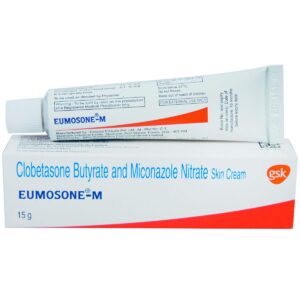CLOBETASONE + MICONAZOLE
Clobetasone: Clobetasone, also known as clobetasone butyrate, is a corticosteroid medication that is used topically to treat various skin conditions such as eczema, dermatitis, and psoriasis.
Its mechanism of action involves reducing inflammation and suppressing the immune response in the affected area. This helps to alleviate symptoms such as redness, itching, and swelling.
Clobetasone is available in the form of creams, ointments, and lotions, and it is typically applied thinly to the affected area of the skin once or twice daily. The exact dose and duration of treatment may vary depending on the severity of the condition and the individual’s response.
Common side effects of clobetasone include skin irritation, burning, itching, and dryness at the site of application. Prolonged use or excessive application of the medication may cause thinning of the skin, discoloration, and increased sensitivity. It is important to follow the prescribed dose and avoid applying it on large areas of the body for long periods of time. If any severe or persistent side effects occur, it is recommended to seek medical advice.
It is always important to consult a healthcare professional before starting any new medication, as they can provide specific dosage instructions and advice based on an individual’s medical history and condition.
Miconazole: Miconazole is an antifungal medication that is used to treat various fungal infections. It can be used to treat infections of the skin, nails, and vagina, as well as oral thrush and fungal infections of the mouth and throat. Miconazole comes in different formulations such as creams, powders, sprays, and suppositories.
The mechanism of action of miconazole involves inhibiting the synthesis of ergosterol, a component of the fungal cell membrane. This leads to the disruption of the cell membrane, ultimately killing or preventing the growth of the fungus.
The dose of miconazole depends on the specific formulation and the type of infection being treated. For example, for vaginal yeast infections, a typical dose might be a 100 mg suppository inserted into the vagina once a day for 7 days. The cream or powder formulation is usually applied to the affected area of the skin or nails, following the instructions provided by the healthcare professional.
As with any medication, miconazole can cause side effects. Common side effects may include itching, burning, or irritation at the site of application. In some cases, skin rash or allergic reactions may occur. If miconazole is used orally, there may be a metallic taste in the mouth. It is important to inform a healthcare professional if these side effects occur or if there are any signs of a severe reaction such as swelling, difficulty breathing, or hives.
It is worth noting that interactions can occur between miconazole and certain medications, such as warfarin (a blood thinner) or drugs metabolized by the enzyme CYP3A4. Therefore, it is crucial to inform a healthcare professional about all current medications to avoid potential interactions.
Overall, miconazole is an effective antifungal medication used to treat a variety of fungal infections. However, it is important to follow the instructions given by a healthcare professional and report any side effects or allergic reactions that may occur during treatment.

